Architectural Significance and Community Impact of Al Waleed Building
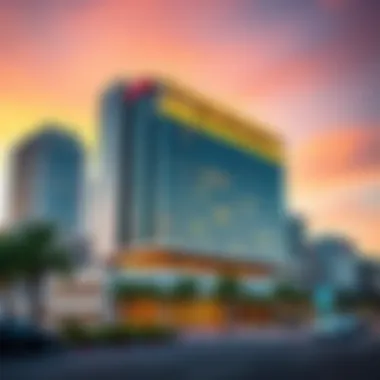
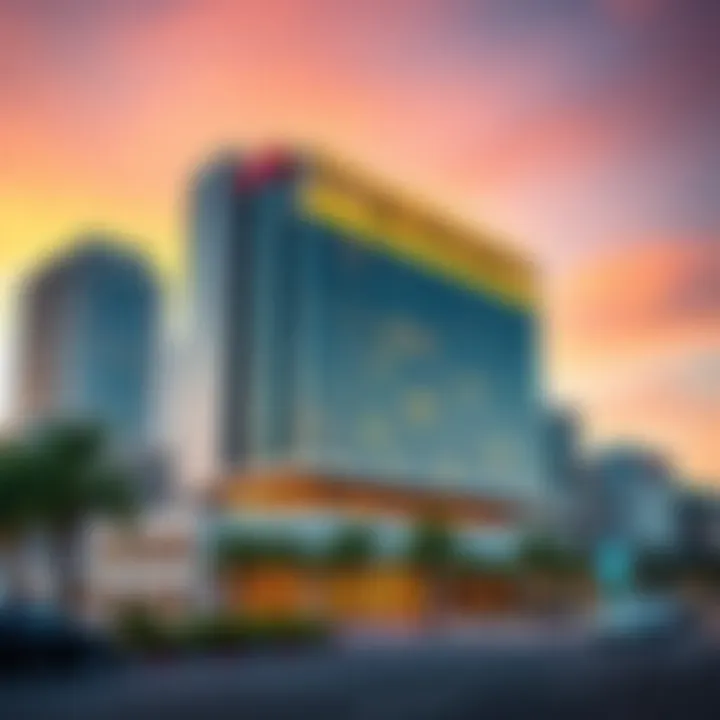
Intro
The Al Waleed Building has become a landmark in Dubai, capturing imaginations with its grand presence amidst a city known for its remarkable skyline. It’s not just a structure rising towards the heavens; it embodies the very spirit of the community surrounding it. From its architectural design to its influence on local culture, the building deserves a closer look.
This article seeks to unpack various facets of the Al Waleed Building, from the historical narratives that shaped its conception to its role in enhancing the lives of those who live and work in its vicinity. We will touch upon how it integrates into the urban layout of Dubai, weaving together stories from residents, expatriates, and tourists. Each perspective adds a layer of depth, revealing the building's multifaceted impact on this bustling metropolis.
In exploring the Al Waleed Building, we will examine:
- The cultural vibrancy it nurtures within the community.
- The lifestyle and amenities it provides and how they cater to the needs of a diverse population.
As we journey through these topics, we aim to illuminate the significance of this architectural marvel, making it evident that its importance extends far beyond aesthetic appeal.
Historical Context of the Al Waleed Building
The Al Waleed Building's historical context serves as a crucial framework for understanding its significance in both the architectural landscape of Dubai and the society surrounding it. This iconic structure embodies more than just modern aesthetics; it represents a pivotal moment in Dubai's transformation into a global hub. From its inception, the Al Waleed Building found itself at the intersection of rich cultural heritage and radical urban development, illustrating how history shapes and is shaped by architecture.
Origins and Development
The roots of the Al Waleed Building can be traced back to a time when Dubai was a humble fishing village, boasting a coastline rather than a skyline. Born out of necessity, the architectural development in the city accelerated rapidly during the late 20th century as oil revenues transformed its economic landscape. The Al Waleed Building was designed in the early 2000s during this boom period.
Its construction marked a turning point; it aimed not only to house various commercial ventures but also to symbolize the modernity that Dubai was striving to embrace. Developed by a consortium of local and international architects, the building is a manifestation of collective aspirations, from local business magnates to the global architectural community.
Living up to its name, which suggests a connection to wealth and prosperity, the Al Waleed Building features a blend of traditional Arabic motifs blended with contemporary materials. Its height and grandeur became a benchmark for future developments in the area. The construction was a feat of engineering, pushed along by rapid urbanization and an increasing demand for commercial spaces that integrate elegantly with the city's cultural fabric.
"The Al Waleed Building is not merely a structure; it is a bold statement about the future direction of Dubai, where tradition meets innovation."
Influences in Design
What sets the Al Waleed Building apart in Dubai's architectural lexicon is the rich tapestry of influences that stitched together its design. From Islamic architecture's intricate geometries to the sleek lines of modernism, the building strikes a unique balance. Influencial figures in global architecture contributed to its creation, often bringing forth elements of their unique styles while harmonizing them within the local context.
The use of local materials not only pays homage to traditional practices but also enhances sustainability efforts, a critical concern in today’s environmental discourse. This emphasis on sustainability reflects a broader trend in architectural practices where modern designs increasingly consider their ecological footprints.
Notably, the integration of cultural symbolism in the design serves a dual purpose: it honors the area's rich history and provides a reference point for community identity amid rapid change. By embedding cultural references into contemporary design, the Al Waleed Building stands as a bridge connecting the past and the future, becoming a focal point in community gatherings and a visual landmark in the ever-changing landscape of Dubai.
In summary, the historical context and the influences in design of the Al Waleed Building underscore its significance beyond its physical structure. It reflects the dynamic interplay of culture, economy, and architectural innovation, weaving together the fabric of Dubai's identity.
Architectural Features
The architectural features of the Al Waleed Building are not just a collection of aesthetics; they embody a narrative that speaks to the heart of Dubai's ever-evolving landscape. Each design decision carries weight and significance, contributing to both the building's character and its relationship with the urban environment. Understanding these elements is crucial for grasping how the Al Waleed Building functions as a bridge between modernity and tradition, elevating the city's architectural discourse while enhancing community life around it.
Unique Design Elements
The Al Waleed Building boasts a variety of unique design elements that set it apart from its counterparts. One striking feature is its distinctive facade, which combines reflective glass with intricate mashrabiya patterns. This not only offers a nod to traditional Islamic architecture but also serves a modern purpose by reducing heat absorption, making the interior more comfortable.
Another element worth noting is the building's layered balconies that project from the structure, providing residents with additional private space while celebrating the outdoors. This architectural choice does more than enhance visuals; it encourages social interaction among tenants and fosters community ties, a vital component in the bustling atmosphere of Dubai.
Materials and Sustainability
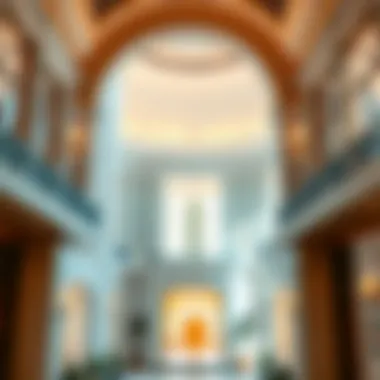
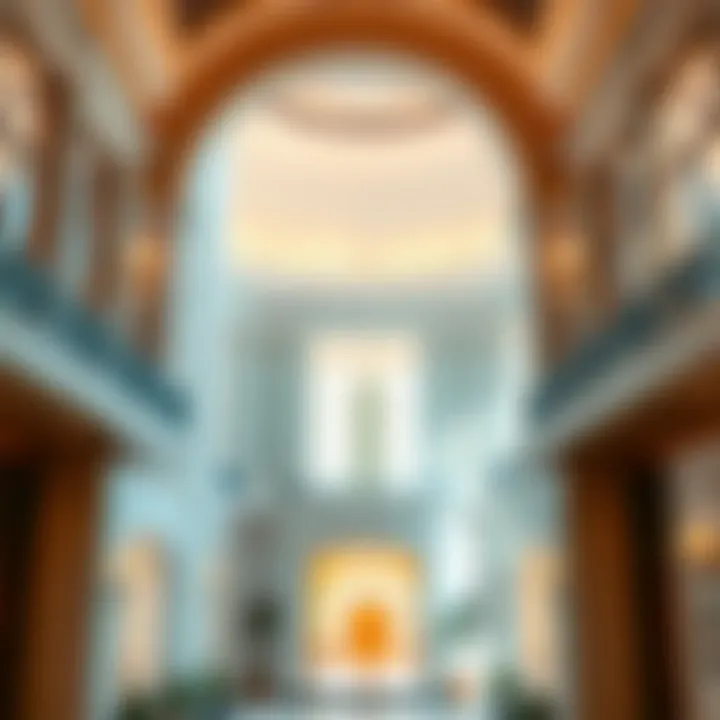
In terms of materials, sustainability is at the forefront of the Al Waleed Building's design philosophy. The use of locally sourced materials not only reduces the carbon footprint but also supports regional craftsmanship. Recycled steel and glass were chosen for their durability and minimal impact on the environment. This drives home a crucial factor in modern architecture: the commitment to eco-friendly building practices. It’s now clear that sustainable construction is not merely a trend but a lasting change in how communities think about their living spaces.
Comparative Architectural Analysis
Similar Buildings in Dubai
When comparing the Al Waleed Building to similar structures in Dubai, it becomes evident that the city is rich with residential projects that reflect both innovation and respect for cultural heritage. Think of the Burj Khalifa or The Address Downtown; they share a common goal of merging grandeur with functionality. However, the Al Waleed Building differentiates itself through a community-centric approach, emphasizing not just luxury but also livability. The integrated public spaces found here encourage social engagements, which is an aspect sometimes overlooked in other skyscrapers.
Global Architectural Trends
On a broader scale, the Al Waleed Building resonates with global architectural trends focusing on mixed-use developments. By incorporating both residential and commercial spaces, it serves a dual purpose that caters to the needs of its inhabitants and the greater community. This trend reflects a shift seen worldwide—an inclination towards creating spaces that foster interactions, ensuing a sense of belonging. Notably, the principle of biophilia, or the human connection to nature, often influences such developments. In the case of the Al Waleed Building, green terraces and vertical gardens contribute not just to aesthetics but also improve air quality and enhance the mental well-being of residents.
By exploring these architectural features, we see how the Al Waleed Building isn't just a structure; it acts as a living part of Dubai, reflecting its unique identity and promising future.
Community and Social Dynamics
The fabric of any city is woven by its community. When discussing the Al Waleed Building, its influence extends far beyond the walls of this remarkable structure. This section delves into how this skyscraper interacts with the local population, shedding light on both its social ramifications and the pivotal role it plays in community dynamics.
Impact on Local Community
Right from its inception, the Al Waleed Building was designed with the community in mind. It provides a hub where people gather, work, and socialize. The presence of cafes, parks, and retail spaces at its base fosters an environment where interaction thrives. For many residents, the building is not just a place to live or work; it’s a centerpiece around which social lives revolve.
Consider a weekend afternoon. Families stroll around, perhaps grabbing a coffee or visiting a food truck that opens up its window to a bustling crowd. Here, the structure serves as a beacon, bringing people together irrespective of their backgrounds.
Moreover, the Al Waleed Building has contributed to local job creation. Employing a diverse group of individuals, it supports the economy while also facilitating networking opportunities. This has been particularly beneficial for expatriates seeking to establish themselves in Dubai's vibrant job market.
"A building can be more than bricks and mortar; it can be a community’s heartbeat, pulsing with life and opportunity."
Interactions with Residents
The interactions facilitated by the Al Waleed Building reveal a lot about community dynamics in Dubai. The management team organizes regular events that invite residents to participate, creating a sense of belonging. Here, informal meet-ups and community service programs blend personal growth with social responsibility.
Residents often voice their feedback, whether it be a suggestion to enhance shared spaces or concerns regarding maintenance. Such interactions not only foster a sense of ownership but also help shape the building into something that caters to everyone’s needs.
Moreover, the architectural design encourages a blend of public and private spaces. With open-air cafes and gardens, residents can unwind while simultaneously engaging with diverse groups of people, fostering cross-cultural dialogues.
In summary, the Al Waleed Building's role in enhancing community and social dynamics cannot be overstated. Its influence reaches far and wide, instilling a vibrant and inclusive community spirit while offering a structured environment that supports both personal and collective growth.
Cultural Significance
The Al Waleed Building is not just another tall structure in the ever-expanding skyline of Dubai; it embodies a plethora of narratives that contribute to the cultural fabric of the city. Its significance goes beyond architectural prowess; rather, it resonates with the values, expressions, and lifestyles of the local community. The building acts as a physical manifestation of a blend between progressive modernity and rich tradition. It serves to anchor the identity of the area while also inviting a diverse crowd to appreciate and explore what it represents.
Role in Local Culture
The role of the Al Waleed Building within local culture is multifaceted. It can be viewed as a beacon of progress and opportunity, where locals and expatriates converge. The architectural design, influenced by various cultural elements, mirrors the melting pot that Dubai has become. People don’t just pass by this structure; they congregate, share experiences, and form connections, thereby reinforcing community bonds.
Beyond its physical presence, the building also acts as an informal gathering space where various cultural dialogues unfold. Here, you may find art installations that reflect local history or hear discussions about architectural innovations that shape the future. This kind of interaction plays a crucial role in fostering an inclusive environment where different backgrounds find common ground.
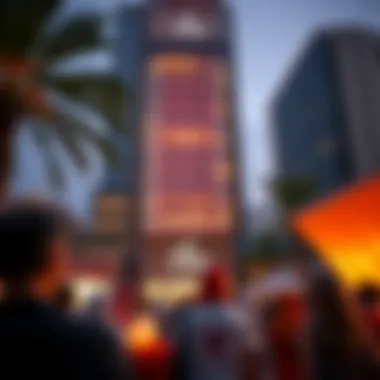
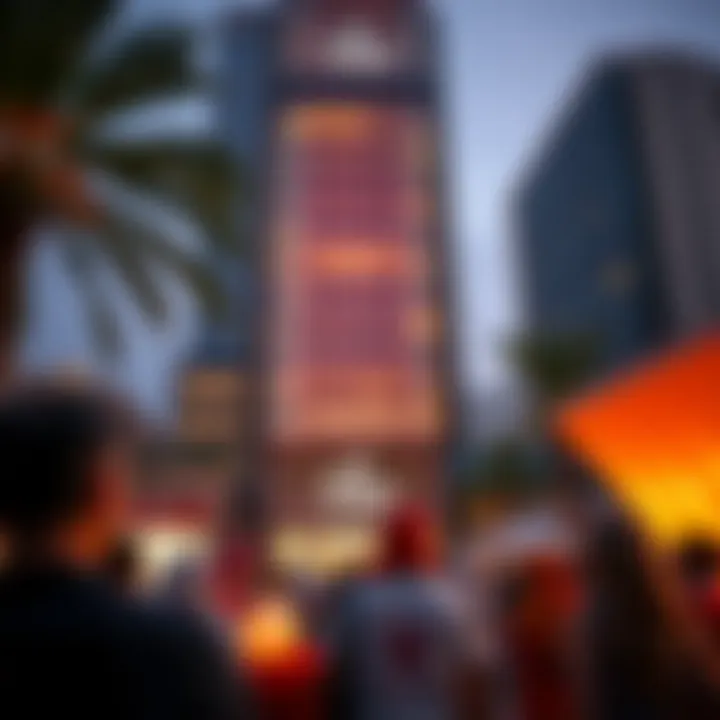
Events and Activities
Annual Festivals
Annual festivals hosted near or even within the Al Waleed Building attract residents and tourists alike, transforming the area into a vibrant hub of cultural celebration. These festivals showcase the essence of local traditions while integrating modern elements that appeal to a broader audience. The highlight of these events is the communal spirit; neighbors become friends, and strangers connect over shared experiences.
For instance, one unique aspect of these festivals is the emphasis on local cuisine, which brings together food vendors, traditional music, and dance. This combination creates an exhilarating atmosphere where participants relish the authenticity of local flavors. It's often said that sharing a meal is one of the best ways to connect, and these festivals capitalize on that notion. However, managing large crowds presents organizational challenges, requiring careful planning to maintain safety and enjoyment.
Art and Exhibitions
On the other hand, art exhibitions hosted in and around the Al Waleed Building bring attention to both emerging artists and established creatives from the region. This initiative not only supports cultural expression but also stimulates dialogue surrounding contemporary issues, thereby enriching the local cultural landscape. One of the standout features of these exhibitions is their focus on interactive installations which invite visitors to not merely observe but also engage.
This kind of involvement allows attendees to contemplate themes, share their views, and even inspire future works of art. The accessibility of these installations means that they draw in diverse demographics, encouraging a sense of community. But it’s worth noting that curating these exhibitions requires balancing artistic content that resonates with varied tastes, which can sometimes lead to discourse about the nature of public art.
Lifestyle and Amenities
The Al Waleed Building is not just a structure; it serves as a vital hub for lifestyle and amenities within its community. Its design and functionality cater to a wide range of needs, fostering a dynamic environment for residents, expatriates, and tourists alike. In understanding the building's role, one must appreciate how these amenities contribute to daily life and communal interactions, enhancing the overall appeal of this prominent landmark.
Residential Benefits
Living in or near the Al Waleed Building presents several advantages. One major benefit is the access to essential services and facilities. Residents enjoy proximity to supermarkets, fitness centers, and recreational areas, all of which cater to the day-to-day needs of modern urban life. The mix of residential spaces within the building promotes a sense of community among inhabitants, encouraging social connections that grow organically. Moreover, safety and security are a key consideration, as the area tends to boast good management and maintenance, ensuring a well-kept environment.
Commercial Spaces
Retail Options
The commercial spaces within the Al Waleed Building include a variety of retail options that significantly enhance the living experience in the vicinity. These retail outlets provide convenience, allowing residents to access everything from groceries to fashion without needing to venture far. This integration of retail not only boosts the local economy but also fosters a sense of belonging among shoppers. A notable characteristic of these retail spaces is their diversity; they cater to various tastes, ensuring that there is something for everyone. For example, local boutiques offer unique products that showcase the culture and craftsmanship of the region. However, it's essential to note that while these options are advantageous, they can sometimes lead to congestion during peak hours, which may deter some from frequenting the area.
Dining Experiences
When it comes to dining, the Al Waleed Building does not disappoint. The restaurants and cafés nestled within provide a broad range of culinary delights, from quick bites to fine dining. These gastronomic establishments enhance the overall community vibe, serving as social gathering points for both residents and visitors. One defining feature of the dining experiences here is the emphasis on local flavors, with many venues promoting traditional cuisine alongside international fare. This aspect not only appeals to the palate but also enriches the cultural tapestry of the area. Nevertheless, as is typical in popular spots, pricing can vary widely, which may affect dining choices for budget-conscious individuals.
"A thriving community is often measured by its ability to meet the daily needs of its residents, and the Al Waleed Building excels in this regard, offering a well-rounded lifestyle that is hard to match."
In summary, the lifestyle and amenities offered by the Al Waleed Building greatly contribute to its significance within the Dubai community. The meticulous blend of residential benefits, vibrant retail options, and diverse dining experiences collectively create an environment that nurtures both individual comfort and communal interaction. This multifaceted approach not only enhances the day-to-day lives of those who dwell nearby but also solidifies the building's role as a central figure in Dubai's thriving landscape.
Visitor Insights and Experiences
Exploring how people interact with the Al Waleed Building provides rich texture to our understanding of its place in the urban landscape of Dubai. Visitor insights offer a window into the experiences of those who wander through its halls or stroll around its premises. Such perspectives are particularly vital as they encapsulate not just the architectural grandeur but also the human connection to this remarkable structure.
Tourist Attractions Nearby
The location of the Al Waleed Building is no happy accident. Nestled in the heart of Dubai, it’s surrounded by a plethora of attractions that draw both tourists and locals alike. Just a stone’s throw away, visitors can engage with several notable sites:
- Burj Khalifa: The tallest building in the world, it offers breathtaking views that complement those from the Al Waleed Building.
- Dubai Mall: This enormous shopping paradise is perfect for those wanting to mix leisure with an urban experience.
- Dubai Fountain: This captivating water feature adds an artistic flair to the nearby area, providing an impressive visual display every evening.
- Souk Al Bahar: A traditional marketplace that captures the essence of Arabian culture, offering unique experiences and products.
Many tourists plan their visits around these landmarks, often sharing stories of how their exploration of Dubai interweaves with their time at the Al Waleed Building. Such interactions emphasize the building’s role as a hub in a vibrant tapestry of attractions, making it integral to the overall experience of the city.
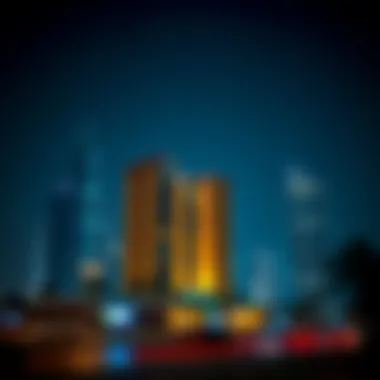
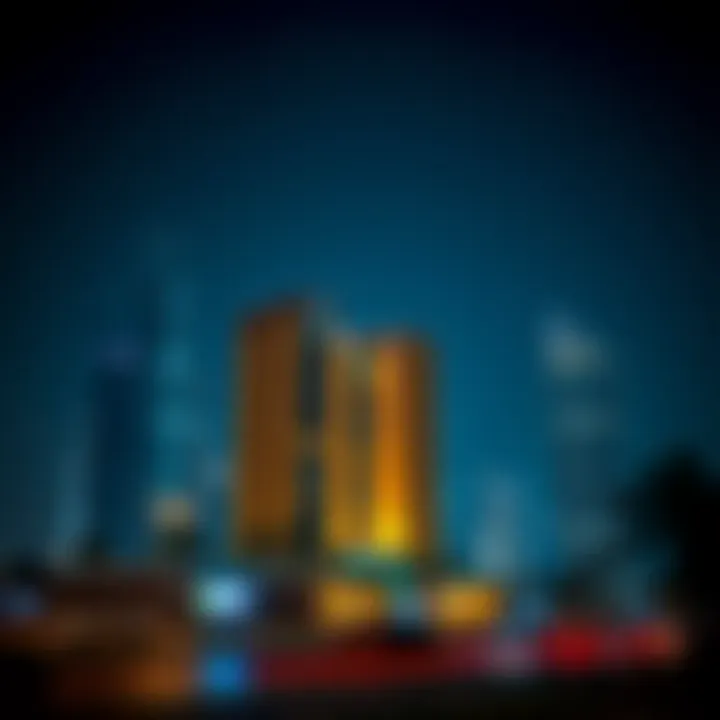
Visitor Feedback
Feedback from those who have visited the Al Waleed Building reflects a diverse range of emotions and impressions. Satisfaction tends to stem from both its exterior beauty and the experiences within.
“The moment I saw the building, I was taken aback. It's not just a structure; it feels alive.”
Comments like this underline how architecture goes beyond mere function; it sparks inspiration and awe. As visitors share their insights, several themes emerge:
- Visual Appeal: Many rave about its contemporary design and how it contrasts with traditional structures nearby.
- Community feel: Visitors often mention how the building serves as a community gathering space, enhancing their overall experience in Dubai.
- Cultural Interaction: Travelers appreciate the opportunities to connect with local culture through events and activities hosted at the building.
Social platforms like Reddit provide spaces for travelers to exchange insights, creating a form of communal storytelling. Phrases like “a must-see” and “a place for every tourist” circulate, encouraging others to venture into the building’s vicinity.
In summary, the visitor insights regarding the Al Waleed Building encompass aspects that range from architectural appreciation to shared experiences, effectively enriching the narrative surrounding both the building and the broader Dubai setting.
Future Developments
As the Al Waleed Building continues to be a cornerstone of Dubai's architectural landscape, the discussion around its future is gaining momentum. This section focuses on what lies ahead, emphasizing the critical elements of proposed enhancements and the long-term vision for this significant structure. These developments are not merely upgrades; they represent a commitment to adapting to the evolving needs of the community, sustainability practices, and architectural trends.
Proposed Enhancements
In the realm of future developments, various enhancements have been proposed for the Al Waleed Building, aimed at both functionality and aesthetic appeal. Some key proposals include:
- Technological Integrations: Outfitting the building with smart technologies that improve energy efficiency and enhance user experience can significantly underscore its modernity. For instance, implementing IoT devices can allow for better monitoring of energy usage, leading to informed management decisions.
- Green Spaces: The idea of incorporating vertical gardens and green rooftops has been tossed around. These elements not just beautify the skyline but also contribute to ecological balance, offering residents a slice of nature amidst a bustling metropolis. Encouraging local flora could enhance the biodiversity in urban settings.
- Community Facilities: Plans to add spaces like coworking zones, cultural centers, or community gardens could transform the building into a multi-functional hub. Such amenities would promote collaboration among residents and create opportunities for community events, fostering a sense of belonging.
Enhancements such as these will propel the Al Waleed Building into a future where it serves as more than just a place to live or work. It will become a vital part of the community's social fabric.
Long-term Vision
The long-term vision for the Al Waleed Building encompasses more than immediate enhancements. It's about envisioning a robust future that honors the building's past while embracing new possibilities. This vision is multidimensional, focusing on several aspects:
- Sustainability Goals: By aiming for higher sustainability standards, the building could set a benchmark in Dubai for environmentally conscious construction. This means not only addressing energy efficiency but also designing waste management systems that promote recycling and reduced landfill use.
- Cultural Fusion: As Dubai thrives on its cosmopolitan identity, the long-term vision could include architectural updates that reflect a blend of cultures. This not only enriches the aesthetic of the building but also resonates with the diverse communities it houses.
- Economic Impact: Beyond aesthetics and community value, there is the economic aspect. By hosting events and becoming a landmark, the building could serve as a magnet for tourists and locals alike, boosting not just its occupancy rates but also the local economy.
In sum, the future of the Al Waleed Building is poised at the intersection of innovation and community needs. It promises to maintain its relevance well into the future, illustrating how architectural importance goes beyond mere construction—it fosters relationships, nurtures well-being, and enhances urban life.
Concluding Thoughts
The Al Waleed Building holds a pivotal position in understanding modern architecture as it integrates functionality and aesthetic appeal while acting as a nexus for the local community. As we delve into the essence of this structure, it’s clear that it’s not merely about bricks and mortar; it’s about connecting people and fostering a sense of place.
Summary of Findings
Throughout our exploration, we touched on several aspects that define the Al Waleed Building’s significance. Its architectural elegance, inspired by both traditional and contemporary styles, reflects the unique blend of cultures found in Dubai. The building's design emphasizes sustainability, highlighting materials that are not just visually appealing but also environmentally conscious. Furthermore, it plays an essential role in enhancing community interaction. Residents and visitors share experiences within its walls, from commercial activities to cultural events that encapsulate the spirit of the city.
Some key points include:
- The building’s unique design serves as a landmark, drawing tourists and bolstering local pride.
- It acts as a hub for various community-oriented events, fostering unity among diverse demographics.
- The integration of sustainable materials signals a forward-thinking approach to urban development.
The Al Waleed Building's Role Moving Forward
Looking ahead, the Al Waleed Building is poised to adapt and evolve alongside the needs of its community. Planners envision further enhancements that not only increase accessibility but also ensure that the building continues to meet modern expectations without losing its core identity. There are plans for more public spaces that can accommodate outdoor gatherings and cultural exhibitions, ensuring that the Al Waleed remains a focal point for social interaction.
Moreover, as urban dynamics shift, integrating technology into the building's infrastructure will be crucial. This could mean leveraging smart technologies that enhance the experience of residents and visitors alike. By remaining committed to sustainability and community focus, the Al Waleed Building can solidify its role as a model for future developments in Dubai and beyond.
"A building is not just about what it looks like; it’s about how it feels to those who inhabit it."
In summary, the Al Waleed Building is a testament to the power of architecture to influence social dynamics and foster connections. It embodies a commitment to sustainability, community engagement, and cultural enrichment, setting a standard for future urban developments.



